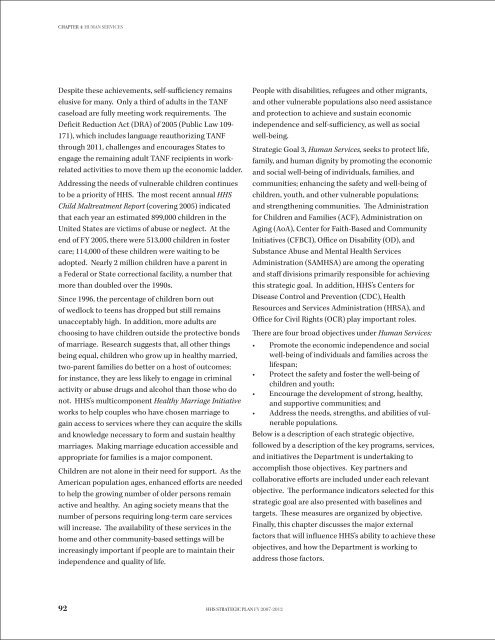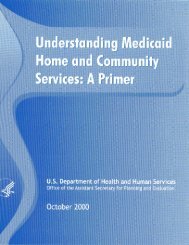STRATEGIC PLAN - ASPE - U.S. Department of Health and Human ...
STRATEGIC PLAN - ASPE - U.S. Department of Health and Human ...
STRATEGIC PLAN - ASPE - U.S. Department of Health and Human ...
You also want an ePaper? Increase the reach of your titles
YUMPU automatically turns print PDFs into web optimized ePapers that Google loves.
CHAPTER 4: human servicesDespite these achievements, self-sufficiency remainselusive for many. Only a third <strong>of</strong> adults in the TANFcaseload are fully meeting work requirements. TheDeficit Reduction Act (DRA) <strong>of</strong> 2005 (Public Law 109-171), which includes language reauthorizing TANFthrough 2011, challenges <strong>and</strong> encourages States toengage the remaining adult TANF recipients in workrelatedactivities to move them up the economic ladder.Addressing the needs <strong>of</strong> vulnerable children continuesto be a priority <strong>of</strong> HHS. The most recent annual HHSChild Maltreatment Report (covering 2005) indicatedthat each year an estimated 899,000 children in theUnited States are victims <strong>of</strong> abuse or neglect. At theend <strong>of</strong> FY 2005, there were 513,000 children in fostercare; 114,000 <strong>of</strong> these children were waiting to beadopted. Nearly 2 million children have a parent ina Federal or State correctional facility, a number thatmore than doubled over the 1990s.Since 1996, the percentage <strong>of</strong> children born out<strong>of</strong> wedlock to teens has dropped but still remainsunacceptably high. In addition, more adults arechoosing to have children outside the protective bonds<strong>of</strong> marriage. Research suggests that, all other thingsbeing equal, children who grow up in healthy married,two-parent families do better on a host <strong>of</strong> outcomes;for instance, they are less likely to engage in criminalactivity or abuse drugs <strong>and</strong> alcohol than those who donot. HHS’s multicomponent <strong>Health</strong>y Marriage Initiativeworks to help couples who have chosen marriage togain access to services where they can acquire the skills<strong>and</strong> knowledge necessary to form <strong>and</strong> sustain healthymarriages. Making marriage education accessible <strong>and</strong>appropriate for families is a major component.Children are not alone in their need for support. As theAmerican population ages, enhanced efforts are neededto help the growing number <strong>of</strong> older persons remainactive <strong>and</strong> healthy. An aging society means that thenumber <strong>of</strong> persons requiring long-term care serviceswill increase. The availability <strong>of</strong> these services in thehome <strong>and</strong> other community-based settings will beincreasingly important if people are to maintain theirindependence <strong>and</strong> quality <strong>of</strong> life.People with disabilities, refugees <strong>and</strong> other migrants,<strong>and</strong> other vulnerable populations also need assistance<strong>and</strong> protection to achieve <strong>and</strong> sustain economicindependence <strong>and</strong> self-sufficiency, as well as socialwell-being.Strategic Goal 3, <strong>Human</strong> Services, seeks to protect life,family, <strong>and</strong> human dignity by promoting the economic<strong>and</strong> social well-being <strong>of</strong> individuals, families, <strong>and</strong>communities; enhancing the safety <strong>and</strong> well-being <strong>of</strong>children, youth, <strong>and</strong> other vulnerable populations;<strong>and</strong> strengthening communities. The Administrationfor Children <strong>and</strong> Families (ACF), Administration onAging (AoA), Center for Faith-Based <strong>and</strong> CommunityInitiatives (CFBCI), Office on Disability (OD), <strong>and</strong>Substance Abuse <strong>and</strong> Mental <strong>Health</strong> ServicesAdministration (SAMHSA) are among the operating<strong>and</strong> staff divisions primarily responsible for achievingthis strategic goal. In addition, HHS’s Centers forDisease Control <strong>and</strong> Prevention (CDC), <strong>Health</strong>Resources <strong>and</strong> Services Administration (HRSA), <strong>and</strong>Office for Civil Rights (OCR) play important roles.There are four broad objectives under <strong>Human</strong> Services:• Promote the economic independence <strong>and</strong> socialwell-being <strong>of</strong> individuals <strong>and</strong> families across thelifespan;• Protect the safety <strong>and</strong> foster the well-being <strong>of</strong>children <strong>and</strong> youth;• Encourage the development <strong>of</strong> strong, healthy,<strong>and</strong> supportive communities; <strong>and</strong>• Address the needs, strengths, <strong>and</strong> abilities <strong>of</strong> vulnerablepopulations.Below is a description <strong>of</strong> each strategic objective,followed by a description <strong>of</strong> the key programs, services,<strong>and</strong> initiatives the <strong>Department</strong> is undertaking toaccomplish those objectives. Key partners <strong>and</strong>collaborative efforts are included under each relevantobjective. The performance indicators selected for thisstrategic goal are also presented with baselines <strong>and</strong>targets. These measures are organized by objective.Finally, this chapter discusses the major externalfactors that will influence HHS’s ability to achieve theseobjectives, <strong>and</strong> how the <strong>Department</strong> is working toaddress those factors.92 HHS Strategic Plan FY 2007-2012
















